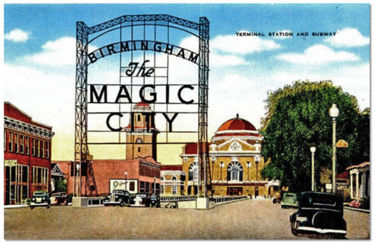The Magic City: Difference between revisions
No edit summary |
No edit summary |
||
| Line 4: | Line 4: | ||
The term was popularized by [[James Powell]], president of the [[Elyton Land Company]]. The earliest published reference so far found was in an editorial by [[W. M. McMath]] in ''[[The Shelby Guide]]'' in which he predicted that the project to build a cotton factory on the banks of [[Shoal Creek]] would make it inevitable that, "Montevallo will eclipse the magic city of Birmingham, and be one of the most flourishing manufacturing cities of the South." | The term was popularized by [[James Powell]], president of the [[Elyton Land Company]]. The earliest published reference so far found was in an editorial by [[W. M. McMath]] in ''[[The Shelby Guide]]'' in which he predicted that the project to build a cotton factory on the banks of [[Shoal Creek]] would make it inevitable that, "Montevallo will eclipse the magic city of Birmingham, and be one of the most flourishing manufacturing cities of the South." | ||
Powell | Powell used of the phrase in his [[1873]] annual report to shareholders. Noting the status of the two-year-old city with 4,000 residents, hundreds of houses and stores, six churches and four hotels, he called Birmingham "this magic little city of ours." | ||
"[[Birmingham, Alabama: The Magic City]]" was the title of an effusive 5-page feature article by Paul Cook in ''National Magazine'' in August [[1906]]. | |||
In [[1926]], a [[Magic City sign|large electric sign]] was erected outside [[Terminal Station|Birmingham Terminal Station]] saying, "Welcome to Birmingham, The Magic City." The phrase and the sign itself are referenced in [[Sun Ra]]'s seminal [[1966]] free-form jazz album ''[[The Magic City (album)|The Magic City]]''. The name is also used for numerous businesses and some events in the city, such as the [[Magic City Classic]], [[Magic City Art Connection]] and [[Magic City Flickr Group]]. | In [[1926]], a [[Magic City sign|large electric sign]] was erected outside [[Terminal Station|Birmingham Terminal Station]] saying, "Welcome to Birmingham, The Magic City." The phrase and the sign itself are referenced in [[Sun Ra]]'s seminal [[1966]] free-form jazz album ''[[The Magic City (album)|The Magic City]]''. The name is also used for numerous businesses and some events in the city, such as the [[Magic City Classic]], [[Magic City Art Connection]] and [[Magic City Flickr Group]]. | ||
Revision as of 17:38, 11 April 2020

The Magic City is the most recognized nickname for Birmingham. It comes from the city's rapid growth, both in its earliest days, and again at the turn of the 20th century when the city's downtown area developed from a collection of small houses and businesses to one of the most impressive downtown areas in the country.
The term was popularized by James Powell, president of the Elyton Land Company. The earliest published reference so far found was in an editorial by W. M. McMath in The Shelby Guide in which he predicted that the project to build a cotton factory on the banks of Shoal Creek would make it inevitable that, "Montevallo will eclipse the magic city of Birmingham, and be one of the most flourishing manufacturing cities of the South."
Powell used of the phrase in his 1873 annual report to shareholders. Noting the status of the two-year-old city with 4,000 residents, hundreds of houses and stores, six churches and four hotels, he called Birmingham "this magic little city of ours."
"Birmingham, Alabama: The Magic City" was the title of an effusive 5-page feature article by Paul Cook in National Magazine in August 1906.
In 1926, a large electric sign was erected outside Birmingham Terminal Station saying, "Welcome to Birmingham, The Magic City." The phrase and the sign itself are referenced in Sun Ra's seminal 1966 free-form jazz album The Magic City. The name is also used for numerous businesses and some events in the city, such as the Magic City Classic, Magic City Art Connection and Magic City Flickr Group.
Birmingham is not the only city that has been known by this nickname. Others include Miami, Florida (which may have used it in the 1890s); Billings, Montana; Minot, North Dakota; and Roanoke, Virginia.
References
- McMath, W. W. (July 25, 1872) "Beat Meeting at Montevallo." The Shelby Guide
- "Magic City." (November 5, 2006). Wikipedia, The Free Encyclopedia. Accessed December 15, 2006 [1].